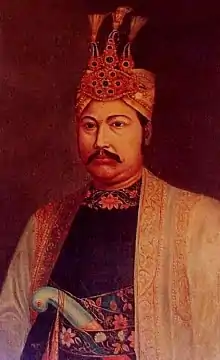Bir Chandra Manikya
Maharaja Bir Chandra Manikya of the Manikya Dynasty was the king of Tripura from 1862 to 1896.
| H.R.H. Maharaja Bir Chandra Manikya Debbarman Bahadur | |
|---|---|
| King of Tripura | |
 | |
| Reign | 1862-1896 |
| Predecessor | Ishan Chandra Manikya |
| Successor | Radha Kishore Manikya |
| Religion | Borok Hinduism |
| Kingdom of Tripura | |||||||||||||||||||||||||||||||||||||||||||||||||||||||||||||||||||||||||||||||||||||||||||||||||||||||
|---|---|---|---|---|---|---|---|---|---|---|---|---|---|---|---|---|---|---|---|---|---|---|---|---|---|---|---|---|---|---|---|---|---|---|---|---|---|---|---|---|---|---|---|---|---|---|---|---|---|---|---|---|---|---|---|---|---|---|---|---|---|---|---|---|---|---|---|---|---|---|---|---|---|---|---|---|---|---|---|---|---|---|---|---|---|---|---|---|---|---|---|---|---|---|---|---|---|---|---|---|---|---|---|
| Part of History of Tripura | |||||||||||||||||||||||||||||||||||||||||||||||||||||||||||||||||||||||||||||||||||||||||||||||||||||||
| |||||||||||||||||||||||||||||||||||||||||||||||||||||||||||||||||||||||||||||||||||||||||||||||||||||||
| Tripura monarchy data | |||||||||||||||||||||||||||||||||||||||||||||||||||||||||||||||||||||||||||||||||||||||||||||||||||||||
| Manikya dynasty (Royal family) | |||||||||||||||||||||||||||||||||||||||||||||||||||||||||||||||||||||||||||||||||||||||||||||||||||||||
| Agartala (Capital of the kingdom) | |||||||||||||||||||||||||||||||||||||||||||||||||||||||||||||||||||||||||||||||||||||||||||||||||||||||
| Ujjayanta Palace (Royal residence) | |||||||||||||||||||||||||||||||||||||||||||||||||||||||||||||||||||||||||||||||||||||||||||||||||||||||
| Neermahal (Royal residence) | |||||||||||||||||||||||||||||||||||||||||||||||||||||||||||||||||||||||||||||||||||||||||||||||||||||||
| Rajmala (Royal chronicle) | |||||||||||||||||||||||||||||||||||||||||||||||||||||||||||||||||||||||||||||||||||||||||||||||||||||||
| Tripura Buranji (Chronicle) | |||||||||||||||||||||||||||||||||||||||||||||||||||||||||||||||||||||||||||||||||||||||||||||||||||||||
| Chaturdasa Devata (Family deities) | |||||||||||||||||||||||||||||||||||||||||||||||||||||||||||||||||||||||||||||||||||||||||||||||||||||||
| Shamsher Gazi (Usurper) | |||||||||||||||||||||||||||||||||||||||||||||||||||||||||||||||||||||||||||||||||||||||||||||||||||||||
Biography
Bir Chandra Manikya is regarded as the architect of modern Agartala city.[1] In 1862, he started the urbanisation of the Agartala. In 1871 he established the Agartala Municipality. He established Umakanta Academy, the first western school in Tripura, in 1890.
An enthusiastic photographer, he was the first king of India to organize an annual photographic exhibition in his palace.[2]
 Maharaja Birchandra with the queen Maharani Manamohini in 1880
Maharaja Birchandra with the queen Maharani Manamohini in 1880
Legacy
The Tagore family had links with the princes of Tripura since the time Dwarkanath Tagore but the relationship between the two families was closest during the time of Bir Chandra's reign. Rabindranath Tagore had a friendly relationship with the king. Three important works of Rabindranath Tagore — Mukuta (1885), Rajarshi (c. 1885), and Visarjana (1890) were directly influenced by his association with the royal family of Tripura.[3] Bir Chandra Manikya was also one of the main characters of the novel Prathom Alo (প্রথম আলো) by Sunil Gangopadhyay.
See also
References
- "AMC at a glance". Agartala Municipal Corporation. Archived from the original on 6 October 2009. Retrieved 8 June 2012.
- "Old photographs - people in India". www.the-south-asian.com. Retrieved 1 August 2020.
- Chattopadhyay, Suhrid Sankar. "Monarchy as model". Frontline. Retrieved 1 August 2020.